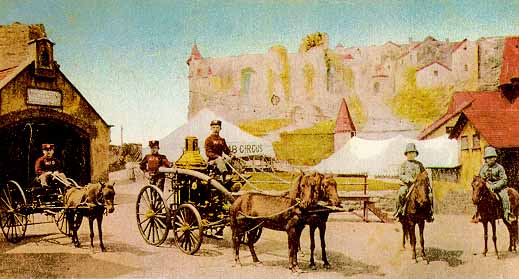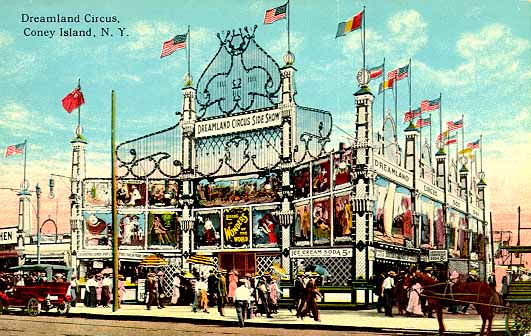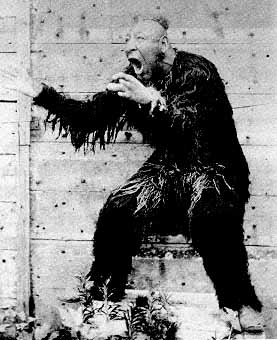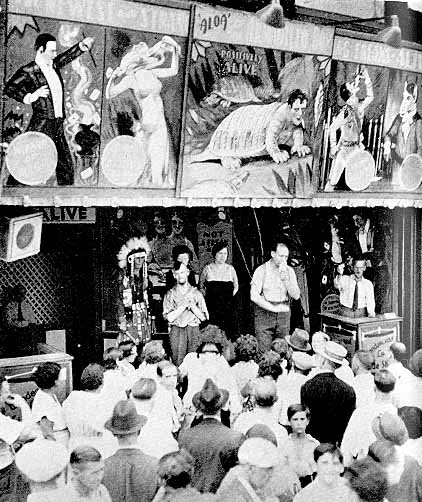Coney Island - Freaks & Shows
While P.T. Barnum elevated the ballyhoo of exhibiting side show circus freaks to an art, it was the arrival of Samuel W. Gumpertz at Coney that brought the freak show to the seashore. Gumpertz, a successful Missouri showman, came to the island at the behest of Senator Reynold's to build and manage a Midget City called Lilliputia for Dreamland's 1904 opening season. He invited 300 midgets scattered across the continent at various World's Fairs and circus sideshows to be the permanent residents of an experimental community. The most famous of the residents were the Count and Countess Magri. The countess had achieved her fame years earlier during her first marriage to the beloved midget, General Tom Thumb.
Lilliputia was built to half scale to resemble 15th century Nuremberg Germany. The midgets had their own parliament, own Midget Fire Department that responded hourly to false alarms, and their own beach complete with midget lifeguards. While they entertained patrons during the day, they had their own lives and community when the park was closed.

| Dreamland's Lilliputia had its own Midget Fire Department. |
Gumpertz success with Lilliputia convinced him to settle permanently at Coney Island. His plan was to scour the world during the off season for the most unusual, outlandish and grotesque of human beings; in short freaks. From 1905 through the late-twenties he visited Egypt five times, Asia five times with side trips to Java and the Philippines, made five trips to the Africa, twice to its unexplored center, and dozens of expeditions to Europe.
In 1905 he transported a tribe of 212 friendly, non-head-hunting Bantocs to America and whisked them past astonished immigration officials. These Spanish speaking Filipinos were proficient in both blowing poison darts through reed guns and wire and brass crafts-making. They appealed to the public's curiosity since they were from the United States newest and remotest colony. When the public began following the news of the kidnapping of an American named Perdicaris by a Moroccan bandit tribal leader named Raisuli, and his subsequent rescue by the U.S. Marines, Gumpertz imported eighteen Algerian horsemen with fierce bearded faces and arrogant manners. In all, Gumpertz imported 3,800 unusual people past the American immigration officials throughout his career.
Gumpertz never settled for less than the real thing. While P.T. Barnum foisted a local black man as the Wild Man of Boreno, Gumpertz went to Boreno and leased nineteen Wild Men from a tribal chieftain for a price of two hundred bags of salt. From Burma he brought woman who had stretched their necks fourteen inches by gradually adding brass rings. A tribe of 125 Somali warriors, that he imported, fascinated the public by rubbing blue clay into self-inflicted wounds as an antidote to internal pain.
He paid the government of French Equatorial Africa, $3000 per week to show how a dozen women, accompanied by their husbands, from the banks of the Ubangi River had stretched their lips over wooden platters up to ten inches wide. The bizarre tribal custom had begun centuries earlier to protect their women from pirate slavery by making their women undesirable. The unforeseen consequences was that their husbands after coming to Coney Island soon found their wives undesirable after they experienced normal kissing with American black women. Two of their wives in an attempted suicide threw themselves in front of moving automobiles, but failed when the cars braked before they hit them.
By 1908 Senator Reynolds had promoted him as Dreamland's general manager. For three years he had to concern himself with mundane chores and the politician owner's whims of the park's overall color scheme or expanding the widths of promenades to accommodate the crowds. But once Dreamland burned during Memorial Day weekend in 1911, Gumpertz was free to devote time to his first love, exhibiting freaks.
He put together the Dreamland Circus Sideshow under a 40 x 80 foot tent along Surf Avenue while the park's embers were still smoldering. He was flanked by a dozen other attractions, either owned or leased by him. There was a constant ballyhoo as each attraction used a barker to draw in a curious paying public. Huge colorful sideshow banners depicted the creatures displayed inside the tent.
The best of the barkers, one without peer, was Omar Sami, "King of the Ballyhoo Spielers." Gumpertz had convinced Omar in 1910 to quit the road of carnival life and work concessions at Dreamland. Omar was the master of the soft sell. He realized early that New Yorkers were more educated than most and that you couldn't talk to them as if they were country hicks. He could mesmerize a crowd with his Indian accent and they would obediently follow him into the show. After Dreamland burned Omar managed the Dreamland Circus Sideshow and other attractions for Gumpertz.
Gumpertz had no trouble convincing Coney's freaks to join his operation. It was a matter of economics; they needed a job. Most preferred the low but steady seasonal pay versus being constantly on the road in search of more lucrative one night stands. Besides most freaks liked the sense of community, of living at Coney among their abnormal peers. Best of all he stroked their egos by treating them as something special and displaying them as something unique. It didn't matter if they were dwarfs, giants, ugly, amazingly obese, had three legs, no arms or legs; the public would pay money to stare at them and gaze in awe.
The 1911 show exhibited Ursa the bear girl; Bonita - Irish fat midget; Fatima - the Nubian woman; Rob Roy - albino wonder; Amy - New York fat girl; Captain Copp - human tattooed art gallery; Baby Alpine - 615 pounds; Schrief Afendl - human salamander. The Dreamland Circus Side Show became an instant success.
Gumpertz's featured a 10-in-1 "pit" show in 1914. Featured were Lionel - the dog faced boy from Europe; an armless French woman who does wonders with her feet and toes; two men over 8 feet tall, a man who weighted 804 pounds. He leased a strip 200 feet deep (7 acres) along Surf Avenue. One third of an acre was for his Dreamland circus Sideshow which had a permanent building.

| Dreamland Circus Side Show on the old Dreamland site. |
The outstanding midget at the resort for more than fifteen years was Baron Paucci, an Italian who stood only 24 inches tall. The Baron liked to wear race-track clothes, bet on the horses and drink champagne. He was quite the ladies man and was quite adept at capturing the hearts of large women. Eventually he did marry a normal size woman, but they separated soon afterwards. Unfortunately he had quite a foul mouth and Gumpertz fired him. However, the midget continued his annoying behavior at a rival side show.
A selection of freaks exhibited at the Dreamland Circus Sideshow in 1917 included: Ursa - the bear girl; Nanette - Parhlan bearded girl; Eli Bowen - legless man; Abomah - tallest lady in the world; Princess WeeWee - height 34 inch, weight 15 pounds, age 23; Ajax - Arabian sword swallower, a 103 year old dancing wild Bushman; Baby Carrie - fat lady; Princess Lillian - albino; Rosita - tattooed Oriental; Delilah - Senegambian Warrior and Sascha - wire-haired gladiator. As many as 30,000 slow moving spectators, each with a sense of amazement, took the twenty minute tour each summer day.
When the United States entered World War I in 1917 many of the side-show freaks did their patriotic duty and enlisted in the Army. There was a parade for all enlistees about to embark for military camp. The Strong Man, the Lion-faced Boy, and the Tattooed Man were among those who marched to martial music and waved flags, while the rest of the freaks, who were unfit for service, cheered on the sidelines.
Siamese twins were especially popular ar Coney Island. Around 1915 the Society for the prevention of Cruelty to Children objected to the appearance of eleven year old Godino and Lucio Simplicio, Filipino Siamese twins. Since the boys didn't have their legal guardians with them, the Filipino resident commissioner in Washington agreed to take the boys under his protection and keep them away from side-shows.
After they won that case the S.P.C.C. raided David Rosen's side show on the Bowery because he was exhibiting thirteen year olds Marjorie and Mary Gibb, Siamese twins from Holyoke, Massachusetts. Rosen avoided trouble by successfully arguing that the girls were still under the custody of their father. While they did return home for awhile because they were shamed by the publicity of their possible separation, they eventually returned.
Perhaps the most popular freak was Zip - "What is It". P.T. Barnum had discovered and exhibited the black skinned freak with the tiny head topped by a small tuft of hair. The fact was that he was an American Negro micro cephalic, better known as a pinhead. His name was William Henry Johnson and was born in the 1840's with a skull that had little cranial capacity. In short he was an idiot. Since nobody wants to pay to see an idiot, barkers proclaimed that he was a creature from Africa that lived with the apes. Gumpertz managed to get an exclusive contract that allowed him to exhibit Zip during the summer season. During the remainder of the year, Zip traveled with the circus. He lived a long and happy life before he died at the age of 84 in 1926. His honorary pallbearers were the Fat Girl, the Tattooed Lady, the Human Skeleton and Cliko the Bushman.

| Zip - "What is It" had such a small skull that he was known as a "pinhead." |
The popularity of the freaks at Dreamland let to many other side shows at Coney Island. In 1922 "Professor" Sam Wagner opened the rival World Circus Freak Show on Coney Island.
The Steeplechase Circus Big Show located on the Bowery near Steeplechase in 1925 had a ten platform freak show. Acts included Bingo - boy with ear of an elephant, a body resembling that of a pig, but with the feet of a human; Princess Marie - girl with 1000 eyes; the Great Leroy - human ostrich and Scalo - a boy with seal fins.
In 1928 Dreamland Circus featured - Professor Heckler's - flea circus; Shadow Harry - who stands for 12 hours in one spot; Moe and Joe - comical dwarf boxers; Lionel - lion faced man; Libbera - double-bodied man; Tony - alligator boy; Emiel - fat boy; Ho-Jo - bear boy; Irene - beautiful fat girl; Londy - the giantess; Rubberneck Harry - the elastic head boy; Electricia - the electric phenomenon; King Roy - king of the albinos; Mme Adrienie - Hungarian bearded lady; Souse -elephant skin girl from Germany. Alligator boys (there were several) had ichthyosis that produced tough scaly patches of skin.
There were numerous fat ladies at Coney Island, but the most beloved was Jolly Irene because she had always had a sunny disposition. She tipped the scales at 689 pounds when she was in her prime, but unlike other fat ladies, her weight was distributed evenly, not just around her stomach. Her vast bulk was the result of personal tragedy. She had been a normal beautiful woman weighing 120 pounds in 1901 when at 21 years old she gave birth to a child. Childbirth kicked her endocrine system out of whack, and soon she began to pack on pounds in earnest. She joined the circus for a time, but became too fat to fit into ordinary railroad cars. She became insulted when they suggested that she ride in the baggage cars and settled down at Coney Island. Instead of ridiculing her, the hundreds of thousands who passed by her platform became infected by her gaiety.
Surprising many of Coney's freaks married and had relatively normal family lives. Jolly Irene eventually married a second time, to a Coney Islander. Jane Barnell, "Lady Olga," Coney Island's most famous bearded lady, who sported a luxuriant beard thirteen inches long, was married four times. There was no telling what pair of freaks would find happiness. This was especially true when Percilla, The Monkey Girl, a victim of a freak condition that caused hair to grow thickly over her face and body, married Benjano, the Alligator Boy, who had ichthyosis, a skin disease that covered him with tough, gray, quadrangular scales.
A tattooed lady named Jean Carroll was originally a bearded lady when she fell in love with a contortionist. He wanted to marry her but without the whiskers. Since she didn't want to leave carnival life, a tattoo artist decorated her back while a physician removed her beard with a electrolytic needle. Years later after her first husband died, she married an outside talker in the 1950's. By then she had more than 700 designs and pictures inscribed on her skin.
The World Circus Side Show competed with Baby Doll - pulchritude queen of the avoirdupois [beautiful fat lady]; Forrest Layman - armless wonder; Henry Bulston - spider boy; Flo Lambert - contortionist; Mrs. Myrtle Corbin - 4 legged girl prodigy; Warren Travis - world's strongest man; Bonita Barlowe - snake enchantress.
The Spider Boy, known as Harry Bulson, began life with crippled legs and consequently developed great facility and strength with his hands and arms. Taking refuge in the woods from the taunts of kids his age, he began swinging like Tarzan from branch to branch through the trees. Sometimes he would hang on by his teeth while he set traps for birds with his hands. People became afraid of the boy who could walk long distances on his hands and bite a half dollar in two with his teeth. Eventually he was confined to a mental institution but escaped by twisting the bars from his cell window. He was given shelter by an old farmer who pitied him. When a carnival passed through the area he became Spider Boy, a side show celebrity. Eventually he moved to Coney Island where he got top billing at Wagner's show.

| One of Coney Island's many freak shows. |
Hubert's Museum located on the Boardwalk featured Princess May Belle - the divided girl; Mrs. Murry - the electric death chair; Amazo - the aeroplane girl and Balanco - doing feats of balance.
The Strand Museum's 1928 bill included Kaki & Koto - pinheads; Nona - American doll lady; Arkoff - human fountain ; Duke - skeleton dude; Lucille - sword box; Belle Bonita - snake enchantress; Martha - beautiful armless wonder; Julee-Julian - half man, half woman.
Many of these side show freaks were side-show martyrs. The Human Fountain, who expelled streams of water from his fingers and toes, endured years of torture because the tiny tubes under his skin required daily meticulous washing so his wounds didn't become infected. Captain Fred Walters, who was billed as the Blue Man, initially began taking silver nitrate to cure his loco motor ataxia. However, he found that the slightly bluish tinge it gave his skin could be profitable if he increased the dosage. Eventually he became too blue to live and when he died his wife and Samuel Gumpertz found a large supply of the chemical in his trunk.
By 1929 when Gumpertz left Coney Island to run the Barnum and Bailey Circus, Wagner assumed his position as Coney Island's foremost impresario of the odd and unusual in humans. New Yorkers had become to educated to believe in the existence of Wild Men so he exhibited Zip's successors simply as pinheads. He managed to find a pair of sisters from Georgia named Pipo and Zipo. He paid their families $75 / week which was a landfall for the family during the Depression. While Pipo only had the intelligence of an 18 month old baby, her sister was considerably brighter. Zipo had the intelligence of a five year old. They were billed as Pip and Flip - pinheads from Peru.
Business had dropped considerably by 1930. While it was possible to attract 20,000 customers a day back in 1915, showman were lucky to attract 8,000 customers a day by the beginning of the Depression. Showmen consequently dropped prices, but then the quality of the freaks began to suffer. It became hard to compete for freaks with the circuses and traveling carnivals.
The popularity of freak shows also declined because it became increasingly difficult to convince a less gullible public that some of the unusual freaks were Wild Men recently discovered in the world's jungles. Then again, the public was becoming tired of being suckered into paying to see creatures that were obvious fakes.
While Gumperez's and Wagner's shows always displayed genuine freaks, others like Rosen defended deception, so long as it was convincing. Rosen's idea of an attractive freak was the Two-mouthed Boy from Texas. In reality he was a Brooklyn boy with a hole in his cheek, a result of an accident. One set of Mexican Siamese twins being displayed by Slim Kelly got into a salary dispute and one sister unhooked herself, walked off the platform and left her twin behind. Most bearded women were actually men and many a Wild Man was a local Negro acting the part. Many strongmen, who could tear a phone book in two, actually weakened the paper by baking it before the show. Of course there weren't any documented cases of real hermophrites but most side-shows always features a half-man, half women.
Rosen's Wonderland Circus Side Show in 1930 exhibited Brownell - the fish leg man; Dr. Garfield - the man without a skull; Edema - the man with a reversible body; and Elephanto - the elephant girl.
The Dreamland Circus in 1930 exhibited Alsoria - the turtle girl; Lepo - leopard boy; Spike Howard - champion strong man who pulled a loaded truck with his teeth; the Happy Family - 12 monkeys that displayed rare intelligence; Mortado - human fountain from Germany; Chemerea - the human balloon; Antonio Gallindo - Cuban who blew smoke through his ears.
In 1930 Wagner almost lost an act when Mr. X was nearly killed in his electric chair when a safety switch refused to work, In 1932 Wagner exhibited the Gibbs Sisters - Siamese twins; Major Mite the world's smallest individual. In 1937 he was exhibiting Zippo and Pipo - pinheads; Edna Price - neon tube swallower; Lady Voltese - electric dynamo.
David Rosen's Wonderland Circus Side Show was featuring Mille - ostrich faced girl; Twisto - as crooked as a corkscrew; Jolly Vi - fat lady; Gloria - escape artist; and Sirena - serpent girl. Rosen, to refute the insinuations that many of his freaks were fakes, in the mid 30's offered the public a thousand dollar reward to anyone who could prove his three-legged girl was a fake.
The Dreamland Circus Side Show in 1931 displayed Rubber Nelson - a man who bounces like a ball; Jolly Irene - fat lady; Eko & Iko (???) and Zippo - ???
Coney Island had animal freak shows, too. The best was Charlie Dooen's Freak Animal Show on Surf Avenue at W. 8th in the early 1930's. His 40 animals included a human faced chicken, a two udder cow (one udder was on its back and the other in the usual place), a 5 legged calf, a six legged sheep, and a human skinned bull. While the animals were unusual, Dooen tried to present animals that weren't repulsive. Surprisingly many of his freak animals had long lives. His freak two�udder cow in 1933 had been in his show eight years.
In the late 1930's Robert Moses, who was the New York City Parks Commissioner, tried to ban ballyhoo and outside lecturers. In 1938 three major operators were brought to trial for violation of the ordinance. They were Wagner (World Circus Side Show), Rosen (manager of Coney Side Show, and Fred Sindell (Palace of Wonders Freak Show).
Sam Wagner's World Circus Side Show in 1940 featured Henry Bulston - Spider Boy; Lady Olga - bearded lady; Stella - homeliest woman in the world; Major Mite - midget; Chief Woo DO and his strange people; and Uncle Charlie Parcansas - oldest man on Earth. A census taker discovered this gentleman who claimed to be 130 years old and was married 17 times.
In 1941 Sam Wagner's World Circus Side Show exhibited Tom Thumb and father - midgets; Princess Marie - chimpanzee; Sealo - the seal boy; Lady Gladys - ventriloquist and expose of the headless girl illusion; Ramona - billed as Europe's miracle sex girl.
In 1955 David Rosen was still operating Wonderland Circus and Palace of Wonders. Although there was much less interest in freaks, he persisted for a few more years.
Currently there are two freak shows operating, Coney Island USA and the International Circus Museum on opposite sides of the street from each other on W. 12th Street. Bobby Reynolds operates the later show as a hobby and labor of love. Dick D Zigun stages his own sideshow, partially funded by the New York City Department of Cultural Affairs.